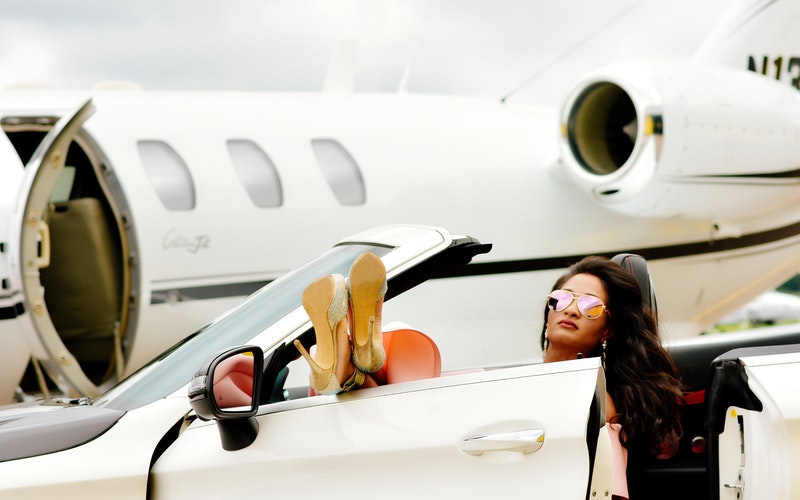If you are thinking of hiring a professional detailer for your jet, it is worth exploring the main differences in services, tools and procedures between private jet detailing and cleaning a bigger aircraft. This will give you a better idea of what airplane detailing involves and who would be your best choice for the job.
The obvious difference between private jet detailing and cleaning a commercial aircraft is the size of the job and what this entails. Small-to-medium jets typically carry 7-12 passengers. While the seating capacity of an average commercial aircraft can range from 150-200 passengers. There is also a noticeable difference between interiors. Private jets are regarded as the ultimate mode of luxurious travel for business and leisure. This is clearly evident in the high-end design of the cabin environment. Take a look at the differences in more detail:
Key Differences Between Private Jet Detailing and Aircraft Detailing
Private Jet Detailing Interiors
Private jet interiors are typically fitted and furnished with high-end materials to create a luxurious, personalized finish. It is important to seek out the services of experienced detailers who know how to clean specific types of upholstery, cabinetry and plating. For example, cleaning calfskin leather seats, wool carpets, polished wood veneers, soft furnishings in velvet, silk or chenille, and metallic finishes like satin nickel or gold plating needs special care.
Luxurious Materials
To protect the look and feel of these materials, it is of the utmost importance to use the correct cleaning techniques and products. There are special products for conditioning leather and other modern cleaning methods that provide exceptional results. For example, DetailXPerts uses steam for upholstery cleaning to dissolve dirt and stains without damaging luxury materials.
Difference Between Interiors
In contrast, the interiors of commercial aircraft prioritize a more functional, practical design to withstand the wear and tear of hundreds of passengers traveling daily. Commercial airline textile materials range from robust wool-blend fabrics to faux leather. The other fixtures and fittings in the cabin are also much less luxurious than a private jet interior with the focus on durable décor that is easy to clean. However, steam cleaning techniques used for private jet detailing are also perfect for sanitizing. Moreover they help to restore the “new cover” appearance of commercial flight seats, including faux leather.
It is always necessary to protect the health of those travelling by air, whether this is by private jet or commercial airline. According to official guidance on aircraft cleaning and disinfection, all disinfectants used inside the aircraft must have no damaging effects on passengers or aircrew. Steam cleaning with organic products can help to safeguard the health of travelers and crew.
Private Jet Detailing Exteriors
The exterior of a private jet is much more accessible than a larger commercial aircraft. The detailing team can usually work at ground level and wash the outside of a small jet using extendable mops or steam-cleaning equipment adapted to enable a longer reach. There is less surface area and fewer cabin windows to clean, too. For larger airplanes, however, aviation-certified platforms are necessary. This enables detailers to access higher, hard-to-reach areas.
Aviation-Approved Cleaning Solutions
Irrespective of the type of aircraft, detailers must use the correct cleaning products. This is because the aircraft’s structure, systems and electronics need protection. Some of the harsher chemicals in cleaning solutions can result in permanent damage to the exterior. Excessive use of water is not great for exteriors, either. There is a risk of damaging landing gear component seals and electrical parts. Using aircraft-specific detailing techniques can eliminate this risk. For example, DetailXPerts follows a process that is compliant with US Environmental Protection Agency standards. Its powerful steam cleaning system removes the most stubborn dirt and can transform aircraft exteriors by using a minimal amount of water along with aviation-approved organic cleaning solutions. There is no harm to paintwork or parts and no chemical runoff on the ground.
Clean and Protect the Exterior
While the exteriors might be different, the reasons for cleaning the exteriors of planes are the same. Regular detailing helps to protect an aircraft from the elements, on the ground and at 30,000 ft. Paint damage may be caused by ultra-violet rays or a build-up of dirt and grease. This damage will affect both the appearance and performance. If you do not pay attention and leave it unattended, the risk of corrosion becomes much higher. Additionally, a clean and polished exterior is important for maintaining a smart and professional appearance. It also reassures passengers that the aircraft is well-maintained and looked after.
Experienced detailers will clean small sections at a time in a methodical manner. For example, they will progress from tail to nose, paying special attention to the tail because this area attracts greater amounts of dirt and grime throughout a flight.
Private Jet Detailing Cleaning Procedures
Simply put, there is more of everything to clean in a commercial aircraft in comparison to a private jet. There are more lavatories, overhead bins, galleys, seats, media devices, monitors, worktops, floor area, windows, and blinds. However, detailers must adhere to the same strict, methodical cleaning procedures regardless of size or type of aircraft.
Methodical Approach
Since the coronavirus outbreak, there has been renewed focus and guidance on aircraft cleaning procedures. This means that efficient cleaning and sanitization measures must be carried out in order to ensure there is a safe and healthy environment for crew and passengers. A methodical approach advises a cleaning progression, working from the cleanest to dirtiest areas. This will mean cleaning the ceiling, overhead bins, reading lights and vent areas, then working downwards to seats and tray tables, finishing off with all the flooring.
Different Cleaning Tools for Specific Areas
Although private jet detailing focuses on a smaller interior space than a larger aircraft, it is still important to allocate individual cleaning tools to specific areas within the aircraft. This helps to minimize cross-contamination. For example, cloths for wiping washroom door handles need to stay separate from cloths used on seat belt buckles. Professional aircraft detailers pay close attention to tray tables, touchscreen video monitors, remote controls, door handles, seat belt buckles, and other frequently touched cabin equipment that easily harbors germs. Effective steam cleaning is another way to ensure there is no cross-contamination.
Different Levels of Cleaning and Size of Cleaning Crew
A lot of hard work goes into detailing the interior and the exterior of an aircraft. Private jet detailing is not a rushed job. It comes with high expectations. Close attention to detail along with efficient deep-cleaning methods will result in a polished exterior and a carefully sanitized interior. It usually involves two to three operatives to complete private jet detailing.
In contrast, there are different levels of cleaning with commercial aircraft. Time is always a factor and this determines the level of cleaning. It ranges from turnaround cleaning to transit cleaning and layover (overnight) cleaning. Deep-cleaning is achievable when the aircraft is free from a tight schedule. Tight working schedules and size of aircraft typically need the services of a larger crew of around four to five. This enables a distribution of cleaning tasks between operatives from vacuuming floors to sanitizing lavatories.
Conclusion
Taking note of the differences between private jet detailing and commercial aircraft will give you a clearer understanding of what each one involves. This is helpful when you are interviewing professional detailers and costing the job. It also highlights the importance of making sure the cleaning crew has experience in this line of work and knowledge in using aviation-grade approved products and methods on both interiors and exteriors.
Are you interested in finding out more about private jet detailing and prices? Check out our Aircraft Detailing services and schedule an appointment with DetailXPerts to have your private jet professionally detailed to the highest standard. Our process is compliant with the standards set by the US Environmental Protection Agency.
Be sure to follow DetailXPerts on Pinterest too. We have a board dedicated to Aviation Lovers and we’ll keep on adding content and ideas there.





